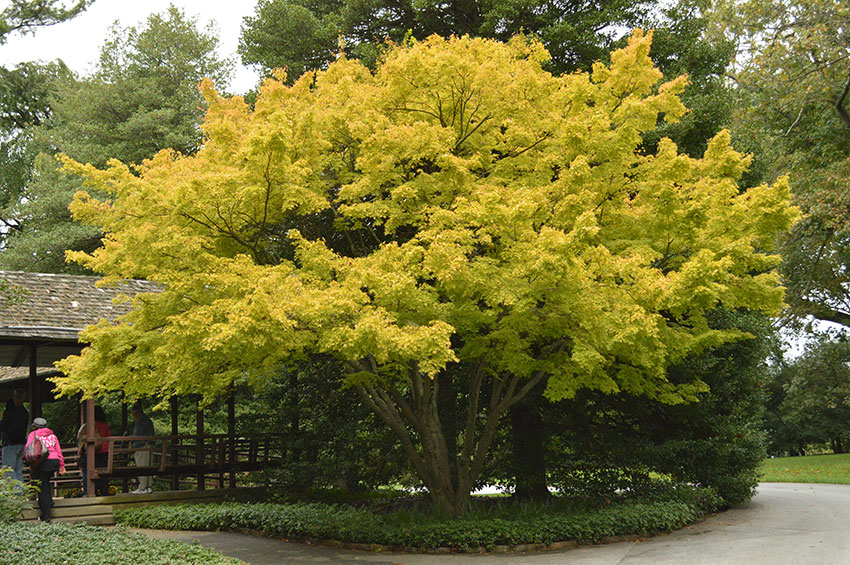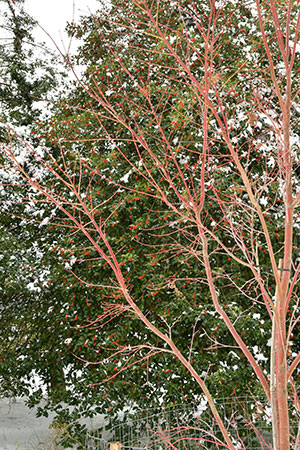
December always conjures up images of preparing for the Holiday season. With cookies needing to be baked, packages wrapped and family and friends visiting from afar, there is little time to focus on the garden. It is a shame, since there are a number of plants that look seasonally fashionable and retain their cheerful colors throughout the winter. A tree I have always deemed most appropriate for the season is the Coral Bark Japanese Maple or Acer palmatum 'Sango-Kaku'. Still unbeknownst to most, its beautiful red stems (Picture 1) bring tree-sized masses of holiday color to the Garden!
Maples are an easily and well-recognized tree based on their characteristic foliage that loosely resembles a hand with outstretched fingers as seen in Picture 2. There are roughly 130 species found throughout North America, Asia and portions of Europe. A member of the Sapindaceae or Soapwort family, fossils bearing a resemblance to Maples date back around 90 million years. The world was much warmer at this point and deciduous forests including Maples extended to the circumpolar regions of the Northern Hemisphere, including Alaska, Greenland and Iceland. Despite its northern presence, the genus is thought to have originally developed in central and western regions of Asia. As the world cooled, these ancient northern forests shifted south, spreading Maples into North America, Asia and ultimately Europe.
The genus name of Acer was crafted in 1700 by the French botanist Joseph Pitton de Tournefort (1656–1708). He was among a small number of botanists who advocated using a singular 'genus' name for a group of related plants. Of course, this idea was furthered by the Swedish botanist Carl Linnaeus (1707–1778) who conceived of binomial nomenclature, whereby a plant is described by a genus name followed by a descriptive species name, as opposed to a descriptive phrase as had been the norm. Tournefort coined the term Acer, most likely from the Latin Acuti meaning sharp. The pointed leaves typical to the genus most likely provided the inspiration for the genus name although Roman soldiers were also known to make sharp pointed spears from the wood of Maples. Another possible root for the name is the Celtic word of Ac meaning hard, as most wood from Maple is certainly hard and spear worthy! The genus was formally described in 1753 by none other than Linnaeus but unfortunately, the true origins of plant's name will most likely remain a mystery!
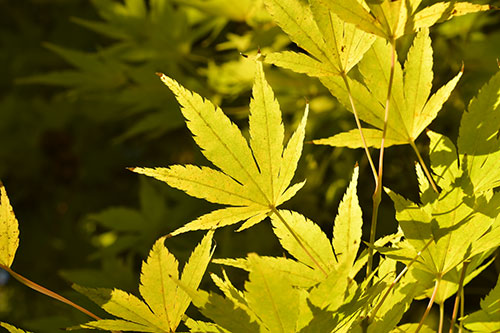
As suggested by the common name, Japanese Maples are found throughout the country of Japan. However, they are also native to Korea, China and southeastern Russia. This species was validly described and named in 1784 by the Swedish physician, botanist and student of Linnaeus, Carl Peter Thunberg (1743–1828). During the years of 1775–1776 Thunberg visited Japan where he exchanged medical treatments with the local physicians and collected plants, much of which remained unpublished until 1784 with the printing of his book, Flora Japonica. The species name is from the Latin Palmātus meaning palm-like or handlike. The name aptly describes the foliage which features a solid, palm-like portion at the leaf base, with 5–9 fingerlike pointed projections. Although variable, the leaf petiole for 'Sango-Kaku' features red highlights when exposed to the sun. The common name of Maple has its roots in the Old English mapulder, meaning none other than Maple Tree.
Japanese Maples are generally small trees with the canopy reaching heights and widths of 20–30', although there are numerous selections that are far smaller in stature. The typically dark green foliage has an equal variation in size, ranging from 1½–4" long and wide. In most cases, the bark found on new growth has a slightly red or dark purple appearance. The stems are attractive on close inspection, but certainly nothing that would be deemed ornamental in winter.
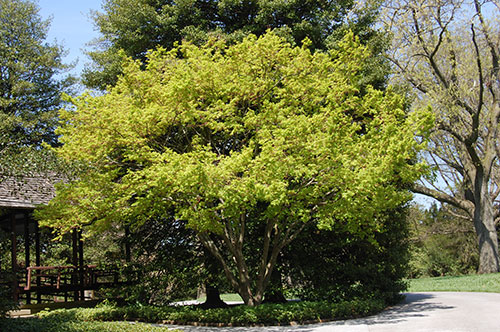
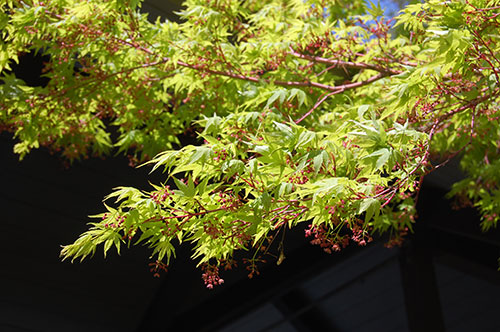
By contrast, Acer palmatum 'Sango-Kaku' has incredibly ornamental bark on new growth, although it does not reach its peak of interest until the colder weather of December. Also appearing in literature as 'Sangokaku' and 'Sango Kaku', the cultivar name means Coral Tower, as Sango means sea coral and Kaku upward growing. When the plant is young, it does indeed have a strongly upward or tower-like growth habit, reminiscent of sea coral. With age, it slowly transitions into a gracefully spreading, oval habit. Although the bark interest diminishes in spring, the light green foliage adds a refreshing glow (as seen in Picture 3) and acts as a perfect foil for the dangling umbels of bright red flowers (Picture 4). The color of the flowers is actually not from the petals but from the subtending leafy calyx. Typical of Maples in general, once the flowers are pollinated the ovaries develop into a fused pair of winged achenes called a samara. An achene is a small nutlet that does not open to release the seed. In the development of samaras, a flat fibrous tissue extends outward from the ovary wall and develops into a winglike appendage as seen in Picture 5. Once the samara detaches from the calyx in late summer and autumn it produces the whirling, wind driven helicopters that have fascinated many a child, including myself. Entertaining to watch, the whirling motion allows the seed to travel far and wide from the mother plant. The wall of the achene does not soften to allow seed germination until the following spring. As a note, the seedlings from 'Sango-Kaku' may have red stems, yet they rarely present the ornamental equal of the parent and it is important not to purchase seedlings as the named selection.
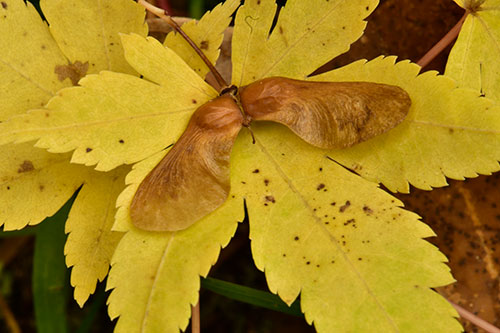
Throughout the summer the foliage retains a light green color, before igniting into a warm yellow (as seen in Picture 5 and 7) with highlights of orange during autumn. However, it is with the onset of colder weather and leaf drop that the real show begins. The stems from the past 8 or so years of growth turn a brilliant red, with the most intense coloration appearing on the growth from the last 3–4 years. The red coloration results from Anthocyanin compounds, which serve to protect the leaf-bare branches from harmful UV rays. It truly appears like a tree you would expect to see surrounded by Santa's Elves at the North Pole, although it is only hardy in zones 5–8. The color looks even more intense when provided with a backdrop of green, the complimentary color of red. A grouping of American Holly (Ilex opaca), Arborvitae (Thuja occidentalis as seen in Picture 6) or Eastern Red Cedar (Juniperus virginiana) are all excellent subjects for a backdrop. The glow of the stems lasts until the onset of spring bud break and the advent of new foliage.
As with all Japanese Maples, 'Sango-Kaku' thrives best when protected from strong winds. The winds subject the plant to leaf burn in summer and twig dieback come winter. The thin bark of Japanese Maples also makes them susceptible to winter bark splitting. This damage starts on cold, below freezing winter days when the late day sun warms the bark. The thin bark also allows warming of winter-dormant cells directly beneath, which become active and start to absorb water. As the sun dips below the horizon, the temperature of the bark and the adjoining, hydrated cells beneath quickly drop to the ambient temperature, causing the cells to freeze and burst. It takes several years for the damage to appear as bark splitting, exposing the inner wood of the tree to decay. Since the bark splits and breaks away during months outside of winter, it creates confusion as to the cause of this mysterious 'illness'. Hence, a design that positions evergreens on the western side of the plant, shielding it from both winds and late day winter sun not only enhances the beauty, but also its health!
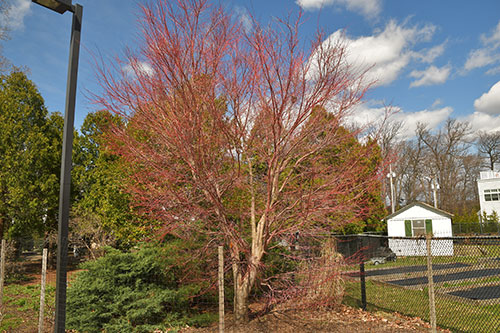
Although it sounds like 'Sango-Kaku' is finicky, it is actually very easy to grow. Plants will grow well in full sun, providing they receive protection from late day winter sun and wind. However, since the plants are typically understory plants in the wild, plants will thrive with the filtered sunlight provided by tall woodlands. Providing a layer of mulch or an attractive groundcover beneath will keep the soil cooler and the moisture more uniform. I have also noticed how plants resent bright nighttime lighting. It interferes with the plants ability to detect shortening daylength and delays the start of winter dormancy, leading to stem dieback.
When plants are young, they will often send vigorous stems skyward that can rub against other stems or create poor crotch angles of less than 45 degrees. Pruning the plant during the initial years proves to be highly valuable for developing a healthy branch scaffolding. Pruning corrections for these stems should be made in late fall when the structure of the plant is visible. Little 'bleeding' of sap will occur in fall since sap is not rising in autumn. Larger limbs can also be removed throughout the summer. As plants mature, it is normal for branches within the canopy to become shaded and die. These are best removed in summer when they are clearly visible.
Acer palmatum 'Sango-Kaku' is a wonderful plant for the garden, providing attractive flowers and foliage throughout the warmer months and a brilliant accent of red stems for December and the winter months to follow. Make a note this December to add this Maple to your Holiday 'must have' list for spring planting. Its attractive glow will make your garden fashionable for many winters to come. Happy Holidays!
